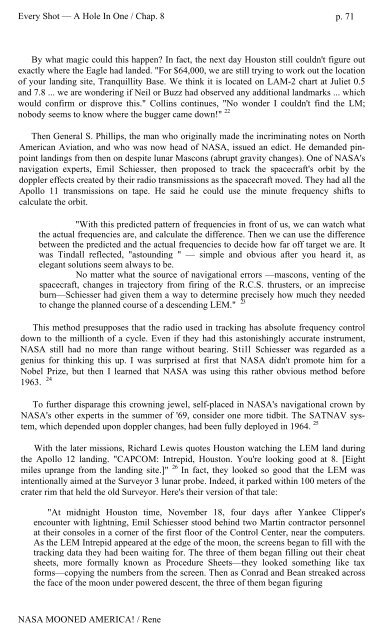Rene-NASA-Mooned-America
Rene-NASA-Mooned-America
Rene-NASA-Mooned-America
Create successful ePaper yourself
Turn your PDF publications into a flip-book with our unique Google optimized e-Paper software.
Every Shot — A Hole In One / Chap. 8 p. 71<br />
By what magic could this happen In fact, the next day Houston still couldn't figure out<br />
exactly where the Eagle had landed. "For $64,000, we are still trying to work out the location<br />
of your landing site, Tranquillity Base. We think it is located on LAM-2 chart at Juliet 0.5<br />
and 7.8 ... we are wondering if Neil or Buzz had observed any additional landmarks ... which<br />
would confirm or disprove this." Collins continues, "No wonder I couldn't find the LM;<br />
nobody seems to know where the bugger came down!" 22<br />
Then General S. Phillips, the man who originally made the incriminating notes on North<br />
<strong>America</strong>n Aviation, and who was now head of <strong>NASA</strong>, issued an edict. He demanded pinpoint<br />
landings from then on despite lunar Mascons (abrupt gravity changes). One of <strong>NASA</strong>'s<br />
navigation experts, Emil Schiesser, then proposed to track the spacecraft's orbit by the<br />
doppler effects created by their radio transmissions as the spacecraft moved. They had all the<br />
Apollo 11 transmissions on tape. He said he could use the minute frequency shifts to<br />
calculate the orbit.<br />
"With this predicted pattern of frequencies in front of us, we can watch what<br />
the actual frequencies are, and calculate the difference. Then we can use the difference<br />
between the predicted and the actual frequencies to decide how far off target we are. It<br />
was Tindall reflected, "astounding " — simple and obvious after you heard it, as<br />
elegant solutions seem always to be.<br />
No matter what the source of navigational errors —mascons, venting of the<br />
spacecraft, changes in trajectory from firing of the R.C.S. thrusters, or an imprecise<br />
burn—Schiesser had given them a way to determine precisely how much they needed<br />
to change the planned course of a descending LEM." 23<br />
This method presupposes that the radio used in tracking has absolute frequency control<br />
down to the millionth of a cycle. Even if they had this astonishingly accurate instrument,<br />
<strong>NASA</strong> still had no more than range without bearing. Still Schiesser was regarded as a<br />
genius for thinking this up. I was surprised at first that <strong>NASA</strong> didn't promote him for a<br />
Nobel Prize, but then I learned that <strong>NASA</strong> was using this rather obvious method before<br />
1963. 24<br />
To further disparage this crowning jewel, self-placed in <strong>NASA</strong>'s navigational crown by<br />
<strong>NASA</strong>'s other experts in the summer of '69, consider one more tidbit. The SATNAV system,<br />
which depended upon doppler changes, had been fully deployed in 1964. 25<br />
With the later missions, Richard Lewis quotes Houston watching the LEM land during<br />
the Apollo 12 landing. "CAPCOM: Intrepid, Houston. You're looking good at 8. [Eight<br />
miles uprange from the landing site.]" 26 In fact, they looked so good that the LEM was<br />
intentionally aimed at the Surveyor 3 lunar probe. Indeed, it parked within 100 meters of the<br />
crater rim that held the old Surveyor. Here's their version of that tale:<br />
"At midnight Houston time, November 18, four days after Yankee Clipper's<br />
encounter with lightning, Emil Schiesser stood behind two Martin contractor personnel<br />
at their consoles in a corner of the first floor of the Control Center, near the computers.<br />
As the LEM Intrepid appeared at the edge of the moon, the screens began to fill with the<br />
tracking data they had been waiting for. The three of them began filling out their cheat<br />
sheets, more formally known as Procedure Sheets—they looked something like tax<br />
forms—copying the numbers from the screen. Then as Conrad and Bean streaked across<br />
the face of the moon under powered descent, the three of them began figuring<br />
<strong>NASA</strong> MOONED AMERICA! / <strong>Rene</strong>


